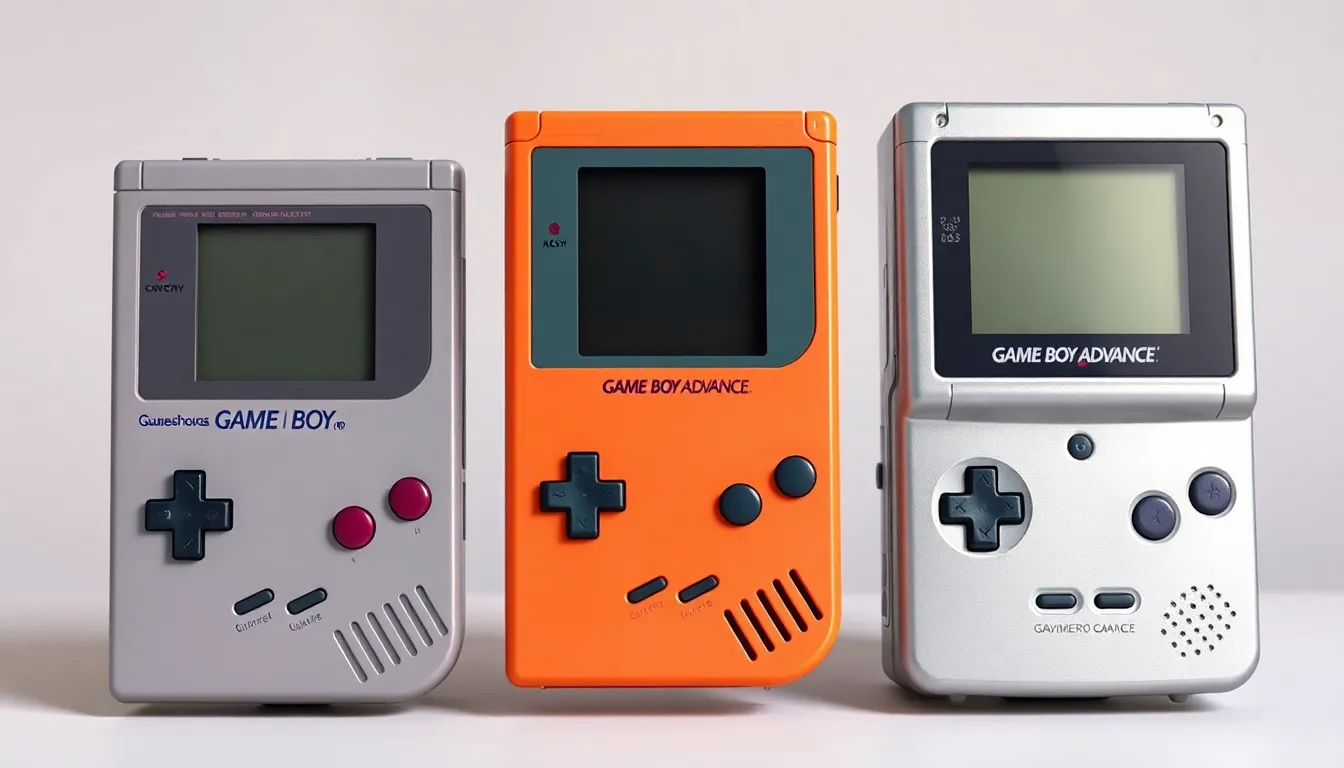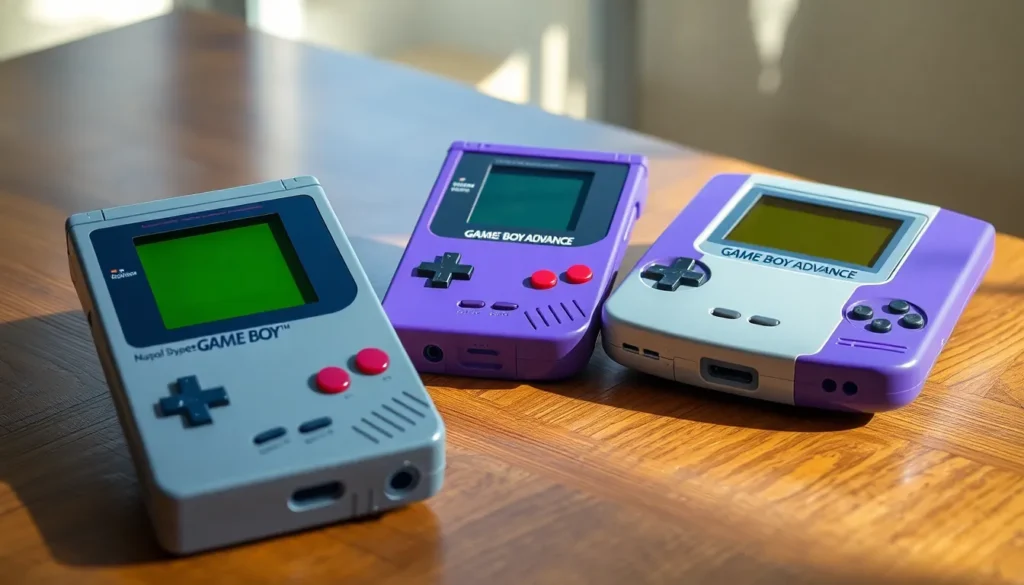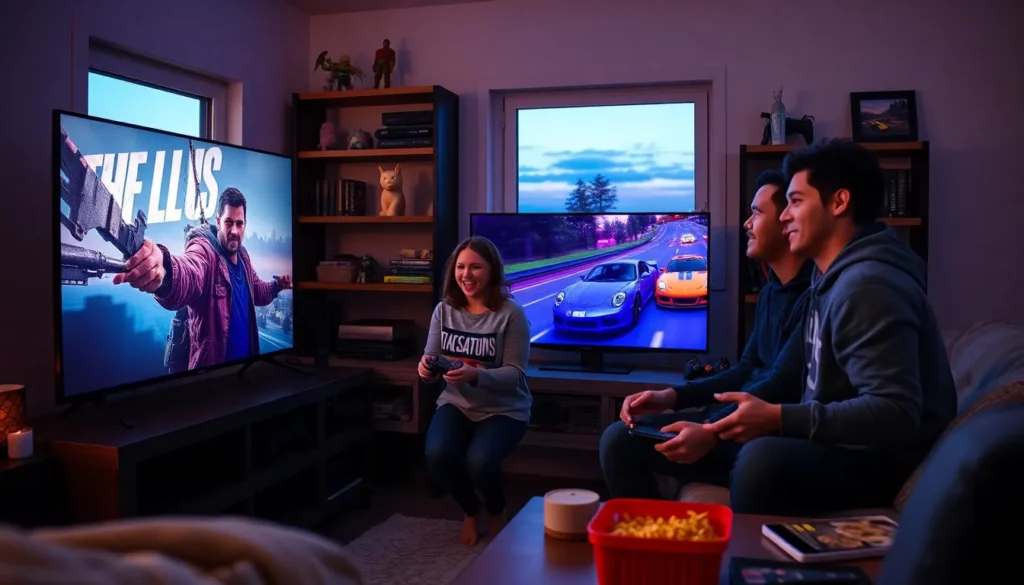Table of Contents
ToggleThe Game Boy revolutionized handheld gaming when it launched in 1989, captivating players with its portable design and iconic titles. Over the years, Nintendo introduced several iterations, each bringing unique features and enhancements. From the classic Game Boy to the sleek Game Boy Advance SP, these devices not only shaped gaming culture but also set standards for future handheld consoles.
In this article, readers will explore a comprehensive comparison of the various Game Boy models. By examining their specifications, design, and game library, gamers can gain insights into which version suits their preferences best. Whether you’re a nostalgic player or a newcomer to the franchise, understanding the evolution of the Game Boy can deepen appreciation for its lasting impact on gaming history.
Overview of Game Boy Models
Nintendo’s Game Boy models significantly shaped the handheld gaming landscape. Each iteration introduced advancements in technology and design, catering to various gaming preferences.
Game Boy
Launched in 1989, the original Game Boy featured an 8-bit processor and a 160×144 pixel monochrome display. It supported interchangeable cartridges, allowing users to play a wide array of games. The rechargeable battery provided approximately 15 hours of gameplay, making it a portable option for gamers. Iconic titles, such as “Tetris” and “Pokémon Red and Blue,” defined its library and reinforced the system’s popularity.
Game Boy Color
Released in 1998, the Game Boy Color marked a significant upgrade with its 16-bit processor and 32,768 color display. This model maintained backward compatibility with original Game Boy games while introducing titles specifically designed for color screens. The battery life remained strong, lasting around 10 hours with color games. Notable releases included “The Legend of Zelda: Link’s Awakening DX” and “Pokémon Gold and Silver,” which showcased the power of the new system.
Game Boy Advance
The Game Boy Advance, launched in 2001, introduced a 32-bit processor and a larger, brighter 240×160 pixel screen. It featured a more ergonomic design, enhancing comfort for extended gaming sessions. With improved graphics and sound capabilities, this model supported a robust library of games, including “Metroid Fusion” and “Pokémon Ruby and Sapphire.” The Game Boy Advance also offered a link cable for multiplayer gameplay, fostering a social gaming environment. Battery life averaged around 15 hours, allowing gamers to play on the go.
Key Features Comparison

The Game Boy series showcases distinct advancements across its models, particularly in display quality, sound capabilities, and battery life. Analyzing these features provides insights into the evolution of handheld gaming.
Display Quality
The original Game Boy featured a reflective monochrome display measuring 2.6 inches, with a resolution of 160 x 144 pixels. The Game Boy Color upgraded to a 2.4-inch color screen, enhancing the visual experience with a resolution of 320 x 240 pixels. The Game Boy Advance introduced a larger 2.9-inch screen, retaining the color display but offering improved brightness and clarity, crucial for vibrant game environments. Each display revolutionized how players interacted with graphics, reflecting the growing demand for immersive gaming experiences.
Sound Capabilities
The original Game Boy included a basic mono speaker, providing simple sound effects and music from games. Advancements in the Game Boy Color allowed for richer audio, adding stereo sound capabilities that enhanced gaming atmospheres. The Game Boy Advance further refined audio quality, enabling more complex soundtracks with a more extensive range of tones. This progression in sound features contributed significantly to the overall gaming experience, allowing more dynamic interactions and immersive storytelling.
Battery Life
Battery life varied among the Game Boy models, affecting gameplay duration. The original Game Boy offered an impressive 30 hours of playtime on four AA batteries, setting a high standard for portability. The Game Boy Color provided around 10 hours on six AA batteries, a decrease due to enhanced display features. In comparison, the Game Boy Advance operated on two AA batteries, offering approximately 15 hours of playtime. This variation highlighted the trade-offs between advanced features and battery efficiency, which remained a crucial consideration for handheld gaming.
Game Library Insights
The Game Boy series boasts a diverse library of games that has defined handheld gaming. Each model offers distinct popular titles and exclusive games that highlight its legacy.
Popular Titles for Each Model
- Original Game Boy: The original Game Boy featured iconic titles like Tetris, which popularized puzzle gaming, and Pokémon Red and Blue, which launched the Pokémon franchise. Additional notable games include Super Mario Land and The Legend of Zelda: Link’s Awakening.
- Game Boy Color: Game Boy Color introduced vibrant titles such as The Legend of Zelda: Link’s Awakening DX, a colorized remake of the original. Other significant games include Pokémon Gold and Silver, which added new Pokémon and features, and Wario Land 3, showcasing unique gameplay mechanics.
- Game Boy Advance: The Game Boy Advance expanded its library with renowned titles like Metroid Fusion, praised for its exploration and gameplay. Other celebrated games include Pokémon Ruby and Sapphire, which introduced new regions, and The Legend of Zelda: The Minish Cap, known for its graphics and puzzles.
Exclusive Games
- Original Game Boy: The original system featured exclusives like Kirby’s Dream Land, which introduced players to the beloved character Kirby, and Dr. Mario, a tile-matching game that gained considerable popularity.
- Game Boy Color: Exclusive to the Game Boy Color, Pokémon Crystal expanded upon the previous titles with new features and storylines. Shantae also debuted on this model, becoming a cult classic due to its unique art style and platforming gameplay.
- Game Boy Advance: The Game Boy Advance offered exclusives such as The Legend of Zelda: Four Swords, which integrated multiplayer gameplay. Advance Wars, a turn-based strategy game, gained acclaim for its depth and strategic challenges.
Performance and Hardware
The Game Boy series showcases a notable evolution in performance and hardware, with each model introducing advancements that significantly enhanced the gaming experience. Key aspects include processing power and compatibility with accessories.
Processing Power
The original Game Boy features an 8-bit custom Z80 processor, capable of 4.19 MHz, delivering satisfactory performance for its time. The Game Boy Color upgraded this to a 16-bit processor, operating at 8 MHz, which facilitated more complex graphics and gameplay. The Game Boy Advance further advanced to a 32-bit ARM7TDMI processor, operating at 16.78 MHz, allowing for improved frame rates and enhanced graphics. This increase in processing power across models contributed to richer gaming experiences, enabling titles such as “The Legend of Zelda: The Minish Cap” to offer detailed visuals and smooth gameplay.
Compatibility with Accessories
Each Game Boy model offers varying compatibility with accessories, enhancing its functionality. The original Game Boy supports a range of peripherals, including the Game Boy Camera and Game Boy Printer, expanding gameplay options. The Game Boy Color maintains compatibility with these accessories while introducing the Game Link Cable, allowing multiplayer functionality with compatible games. The Game Boy Advance supports a wider array of accessories, including the GameCube link cable, facilitating interaction with the GameCube for shared gaming experiences. This evolution in accessory compatibility showcases the adaptability of the Game Boy series to enhance user experiences and gameplay mechanics.
The Game Boy series has undeniably shaped the landscape of handheld gaming. Each model brought unique advancements that catered to both nostalgic fans and new players. From the original’s simple yet engaging gameplay to the Game Boy Advance’s impressive graphics and sound capabilities, there’s a version for every type of gamer.
Understanding the differences in specifications design and game libraries helps players make informed choices. Whether seeking classic titles or the latest innovations in portable gaming the Game Boy remains a significant part of gaming history. Its legacy continues to inspire and entertain across generations.







